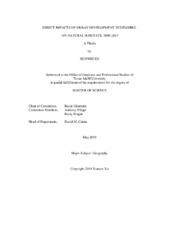| dc.description.abstract | İstanbul is the largest city in Turkey with a total administrative area over 5400 km^2 and a population over 15 million as of 2018. Among the ambitions of the rapidly growing megacity is becoming a major transportation hub in global air travel. The culmination of this ambition, İstanbul New Airport is planned to be the largest airport in the world once completed. However, its chosen location, in the middle of one of the last remaining natural habitats at the outskirts of the city, has drawn great attention due to potential direct and indirect impacts of its construction on these habitats, especially over the forest and coastal areas. This study analyzes the land cover changes due to rapid growth of the city between 2000 and 2015 and specifically focuses on the extent of land change and fragmentation caused by the construction of İstanbul New Airport. The construction of the airport serves as a case study of the impacts of big infrastructure projects on natural habitats in the context of a rapidly growing metropolitan area. To this end, the changes are quantified through land change analysis using Landsat satellite imagery. Furthermore, the changes in the spatial configuration of six land cover types –forest, bare soil, grassland/pasture, barren, built-up and water– are quantitatively analyzed using a representative set of landscape metrics. The results indicate that the construction of the airport and the related road networks did lead to large-scale land cover changes in the study area. Forest cover and grassland/pasture decreased, respectively, by 4% to 2413 km^2 and by 16% to 443 km^2 while built-up land increased by 45% to 955 km^2 . Most of the land changes happened either in the core area of the construction around the new airport or along the area where road networks developed originated from the new airport. In addition, the analysis reveals substantial fragmentation of forest, grassland/pasture and barren lands (of which most is cropland) in the study area. Mean patch size of built-up patches increased drastically, which is a reflection of the rapid growth of the urban areas. Forest and grassland/pasture patches, in contrast, became smaller and more fragmented with increased number of patches and smaller mean patch size. On the European part of the study area where the new airport is located, the number of patches of forest and grassland/pasture increased, respectively, by 2% to 3837 and by 90% to 8078 respectively. On the other hand, mean patch size for forest and grassland/pasture decreased from 0.114 km^2 and 0.032 km^2 to 0.102 km^2 and 0.015 km^2 . Overall, the study provides a comprehensive understanding of direct impacts on landscape of urban development during a period of particularly rapid growth in İstanbul. | en |


